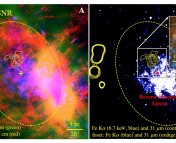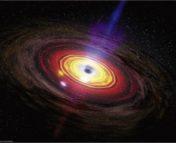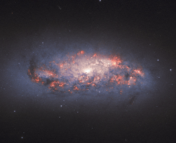Title: Dust entrainment in galactic winds
Authors: Rahul Kannan, Mark Vogelsberger, Federico Marinacci, Laura V. Sales, Paul Torrey and Lars Hernquist
First Author’s Institution: Harvard-Smithsonian Center for Astrophysics, Cambridge, MA
Status: Submitted to ApJL (open access on ArXiV)
The interstellar medium (ISM) of galaxies is a surprisingly windy place. These winds are primarily driven by feedback mechanisms, such as from the galaxy’s central black hole (AGN feedback) or from the stars themselves (stellar feedback). When stars go supernova, they enrich their surroundings with heavy elements (a.k.a metals); as Carl Sagan said, “We are made of star stuff”. The term “stellar winds” describes the overall flow of materials ejected from stars. It turns out these winds don’t just contain metals; they also contain dust. These dust grains play a significant role in regulating star formation activity, especially since molecular hydrogen (stellar fuel) readily forms on the surface of dust grains (this also has a cooling effect, further influencing star formation). Ultimately, given the intricate interplay between dust and star formation, an accurate model of dusty winds is essential towards the understanding of galaxy formation and evolution.
The authors of today’s paper present the results of high-resolution hydrodynamical simulations to see how stellar feedback-driven winds can transport dust grains throughout the ISM and out beyond the outermost reaches of the galaxy’s halo. A key aspect of this simulation is that it takes into account different types of stellar feedback, from supernovae to red giants (or, more generally, AGB stars), as well as the effects of gas and metallicity. The simulation itself uses a self-consistent dust formation and destruction model. Dust is primarily produced from stellar feedback, coupled with growth from existing dust grain, but it can also be destroyed in astrophysical shocks. Simulations were conducted with models of the Milky Way (MW) and Large Magellanic Cloud (LMC).
Hot Tenuous vs. Cold Dense
The simplest way to characterise the “dustiness” of a region is to consider its dust-to-gas ratio (D). The dust content of galactic winds can thus be described as the ratio Dwind/Ddisk, where Dwind is the dust-to-gas ratio of the wind and Ddisk is the dust-to-gas ratio of the galactic disk. This is also known as the relative dust-to-gas ratio.
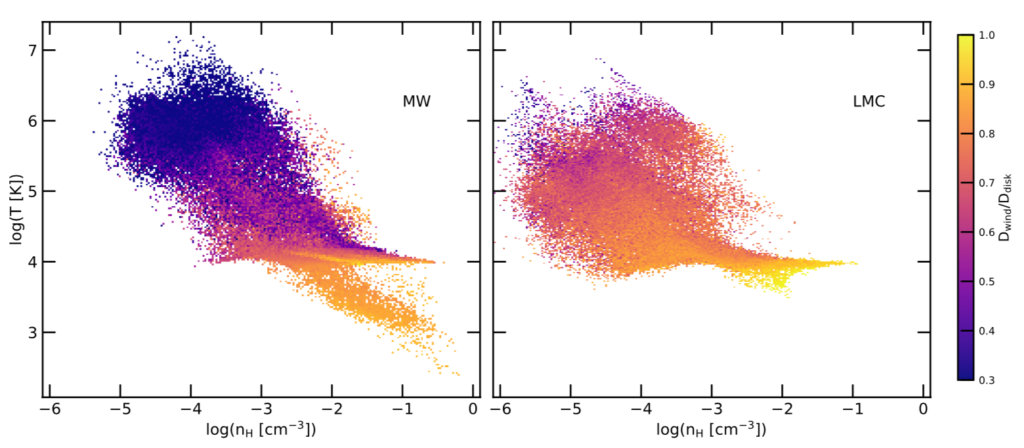
Figure 1 shows how the dust-to-gas ratio changes as a function of temperature and density. In general, cooler, denser regions harbour more dust (as a ratio of gas) compared to hotter, more tenuous regions. Indeed, the authors note a strong overall dependence on temperature, as well as distinct cold-dense and hot-tenuous phases. Considering that high-temperature gasses are primarily ejected from supernovae, the associated shock waves likely destroy most of the dust, hence the lower dust-to-gas ratio. However, the cold-dense material is largely unaffected by astrophysical shocks, thus the higher concentrations of dust.
His Dark Materials
Galactic winds are typically strong enough to transport dust grains from within the ISM and propel them out into the galactic halo. We define the mass of dust located beyond the stellar disk as the extraplanar dust mass. Does this extraplanar dust mass depend on the mass of the galaxy?
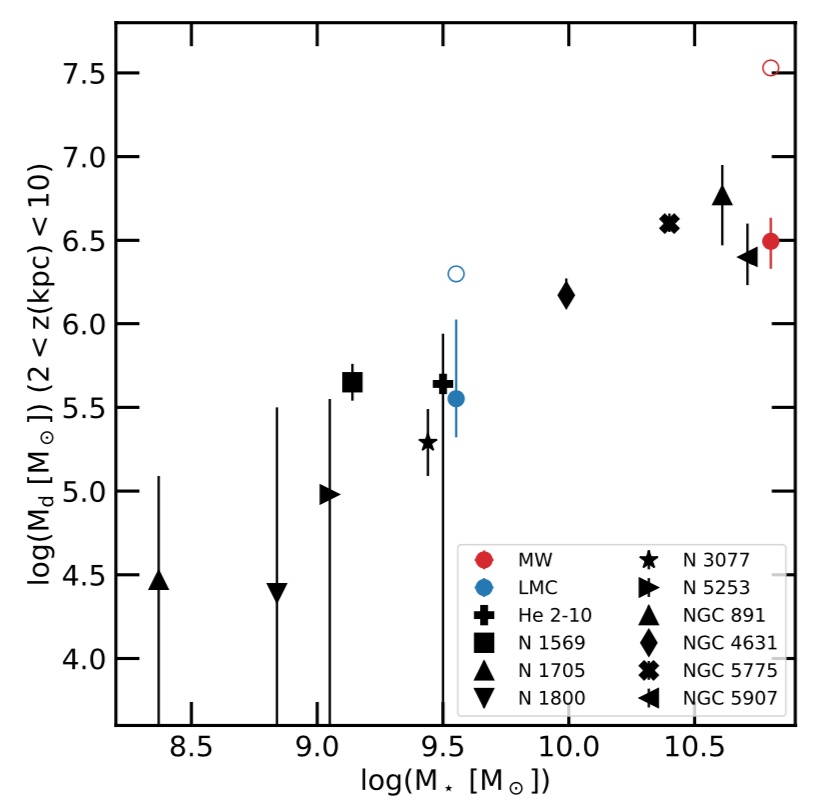
Figure 2 shows that the extraplanar mass as a function of the stellar mass of the galaxy. Indeed, the more massive the galaxy, the more extraplanar dust. However, we observe that the actual extraplanar dust content is significantly less than the total dust ejected over the duration of the simulation time (compare the filled circles with the unfilled circles). This is since most of the ejected dust ends up falling back into the disk (akin to a fountain). To account for the general trend in Figure 2, the authors suggest that higher mass galaxies have dustier disks. This is since more massive “red and dead” galaxies generally have older stellar populations; hence a greater build-up of dust from stellar feedback.
Strange Loops
The evolution of galaxies relies on many feedback loops, many of which are multi-tiered and involve several processes. For instance, supernovae release dust (and heavy metals), in turn altering the molecular hydrogen content, allowing new stars to be born, and so the cycle repeats. Galactic winds, in particular winds containing dust, are a manifestation of stellar feedback. In a similar fashion, galaxy’s extraplanar dust is a marker of its recent star formation history. Just as the Sirocco can influence the tides in Venice, so too can galactic winds drive the ebb and flow of star formation.

